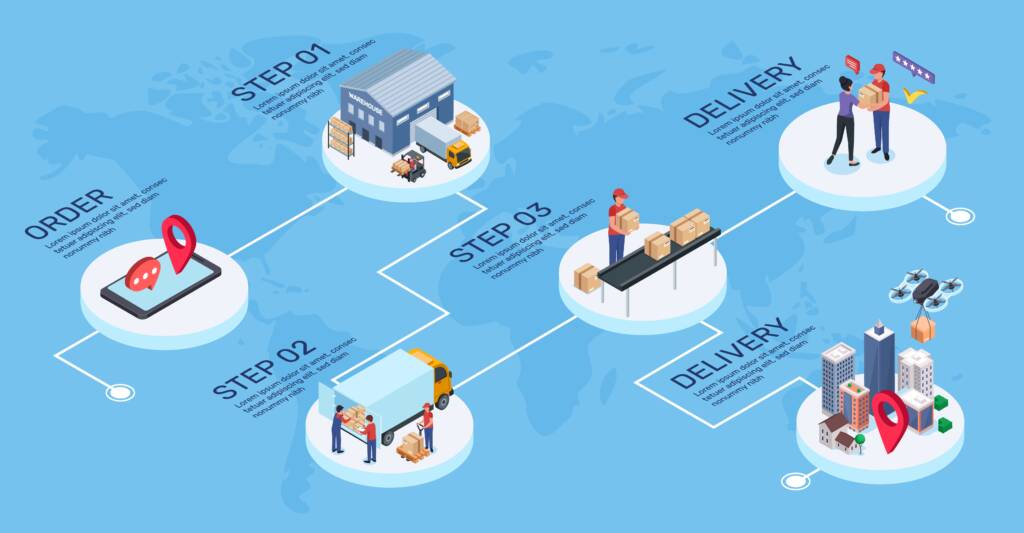Could Enterprise Mobility Help Relieve Retail Worker Stress Across the Supply Chain?

 When you hear the word “retail,” you likely picture a bustling department store or trendy boutique, with shoppers walking through aisles, associates stocking shelves and manning check-out counters, someone monitoring the dressing room area, and perhaps even a greeter as you enter or thanking you as you leave. However, the retail environment is so much more than a clothing store. Retail encompasses things like hardware stores, grocery stores, technology stores and anywhere a person goes to buy goods, both in-person and virtually.
When you hear the word “retail,” you likely picture a bustling department store or trendy boutique, with shoppers walking through aisles, associates stocking shelves and manning check-out counters, someone monitoring the dressing room area, and perhaps even a greeter as you enter or thanking you as you leave. However, the retail environment is so much more than a clothing store. Retail encompasses things like hardware stores, grocery stores, technology stores and anywhere a person goes to buy goods, both in-person and virtually.
But, the retail environment extends even beyond the physical or virtual store front. It also relies on all of the supply chain, manufacturing, and distribution teams that ultimately are responsible for getting product into the store. So many people are responsible for getting these products into your hands, and having the right tools in place to connect all of these teams along the chain to ensure delivery is critical.
Retail is not just frontline store associates
Over the last several years, retailers have been laser-focused on providing consumers with more choice in both how and where they shop and how they receive their purchases. This has led to the onset of omnichannel retail experiences. Significant investments are being made in developing new online store fronts, new delivery options and new methods for communicating with customers. While many of these investments are in the “cloud,” they are all reliant on store associates – typically mobile workers – to receive, pick, package and deliver these goods to their final destination.
Physical goods are touched multiple times throughout the supply chain as they move from manufacturer to distributor to retailer and then again within each retailer’s workflows until they end up on a store shelf. At each transaction point, a mobile worker is likely instructed on the next step in the process and are also documenting what has occurred, whether it’s inventory received, damage to a shipment, what has been sent out, and more. This level of accountability is required to ensure the proper flow and reporting of goods. As retailers place more demands on these mobile workers to deliver on the omni-channel promise, the tools these critical workers need to access and receive information, stay current with training and communicate with other teammates or with customers must evolve.
Unified Communication (UC) solutions are being deployed throughout the retail industry at an increasing rate. These solutions often begin as a technology upgrade to existing legacy PBX solutions that will reduce operation and support costs while providing enhanced communication capabilities for office workers. However, mobile workers like those throughout a retail enterprise can leverage these new solutions as well.
Consumer Demand Places More Stress on Retail Workers
Consumer demands are not only driving new sales and delivery channels leading to a necessary omnichannel environment, but they are also placing additional demands on frontline retail workers to meet these demands. In addition to demanding more, consumers are also becoming more sophisticated buyers as information is more readily available. As such, frontline retail workers need immediate access to the same or better information to provide consumers value. Most, if not all, of the required information is available within the retailer’s various information systems or can be gained from internal “experts” on the team.
Until recently, retail workers accessed this information through a variety of tools and methods like backroom or front of store workstations that had access to the company information systems or speaking with co-worker “experts” via a traditional telephone or walkie-talkie. Other workflows these associates were responsible for required even more tools, like scanners or POS (Point of Sale) devices. Each of these devices does a good job of delivering the information or performing the workflow it was designed for, but having to access multiple devices to complete a single function is an inefficient use of the mobile worker’s time. And, having so many different tools are cumbersome to carry while also multiplying the total number of devices that IT must support and keep on hand to equip their team. Fortunately, there is a better way.
A new era of retail technology
The days of single-use devices are behind us. The next leap in frontline worker productivity is being driven by technology convergence or device consolidation into one purpose-built solution to meet all a retail workers’ needs. Mobile workers no longer need to wear the “toolbelt” of multiple single-purpose voice and data communication tools (wireless phone, walkie-talkie, mobile computer, barcode scanner, etc.). While the obvious advantage to a single multi-purpose device is less “stuff” to manage and maintain, it doesn’t stop there. The real benefit is better communication and increased productivity created by a single user interface. Having common technology architecture that eliminates the hurdles created by workers carrying and becoming experts on multiple tools makes onboarding and training much simpler. Managing fewer devices makes life easier by reducing training investments, improving device utilization, simplifying new employee onboarding in high turnover environments and streamlining workflows.
one purpose-built solution to meet all a retail workers’ needs. Mobile workers no longer need to wear the “toolbelt” of multiple single-purpose voice and data communication tools (wireless phone, walkie-talkie, mobile computer, barcode scanner, etc.). While the obvious advantage to a single multi-purpose device is less “stuff” to manage and maintain, it doesn’t stop there. The real benefit is better communication and increased productivity created by a single user interface. Having common technology architecture that eliminates the hurdles created by workers carrying and becoming experts on multiple tools makes onboarding and training much simpler. Managing fewer devices makes life easier by reducing training investments, improving device utilization, simplifying new employee onboarding in high turnover environments and streamlining workflows.
Plus, customer service improves as associates can respond to customer needs more efficiently. Instead of answering a landline at the front of a store when a customer calls in, placing the customer on hold while going to check the shelves or using their walkie talkie to call another associate, then going back to the landline to answer the question, this entire workflow can be accomplished with one mobile smartphone in hand that allows the associate to stay connected to the customer while checking shelves or even accessing inventory information at nearby stores right on the device, leading to increased brand loyalty and improved bottom line.
Spectralink has raised the bar in mobile computing convergence with the release of the Versity Family of enterprise-grade smartphones. The Versity 95 and Versity 92 handsets, complete with optional built-in scanners, contain the leading Android mobile computer features (rugged ergonomic enclosure, barcode scanning, high resolution camera, Android 10, etc.) with Spectralink’s advanced voice communication capabilities. The result is an enterprise smartphone that supports all retail data, communication and application workflows needed for a successful retail enterprise with Spectralink’s world class voice quality, PBX and UCaaS integration.
Versity 95 and Versity 92 enterprise smartphones give retail workers immediate access to data systems and leading retail applications while simultaneously providing best-in-class voice communication to internal experts, vendors, delivery partners and the consumer in one solution. With Spectralink, you get a single device delivering the functionality of several, making the lives of your mobile and frontline workers easier and simplifying things for your IT and Telecom departments who manage your technologies
To learn more about how Spectralink makes mobility work for retail, visit our website.
Contract Spectralink today to learn more about how mobile technology can help in retail environments, improving employee satisfaction, communication, and safety on the job.
Contact Us
I agree to the Privacy Policy.
